Oberlin Alumni Magazine
Winter 2009-10 Vol. 105 No. 2
Obama’s Obies
For these Washington players, the path to power went through Wilder Bowl. Is this the Age of Oberlin in Obama’s White House?
The fanciful notion that Oberlin runs the world—or at least ought to—is a few steps closer to reality. Whether it’s shepherding Supreme Court nominations through confirmation, directing the nation’s response to the H1N1 virus, meeting the needs of 4 million federal employees, protecting equality in the workplace, or deciding which musicians get to perform at the White House, there is now an Oberlin graduate calling the shots.
Many Oberlin alumni have served in the executive administration throughout history. Jacob D. Cox, Class of 1851, was interior secretary for Ulysses S. Grant. Charles Sawyer, Class of 1908, was secretary of commerce to Harry S. Truman. Erwin Griswold ’25 reigned as solicitor general under presidents Johnson and Nixon. Jewel Stradford LaFontant ’43 served as U.S. deputy solicitor general under Nixon, the highest ranking woman of his second term. And Richard Haass ’73 was a key foreign policy player under two Bush presidencies. But never have so many Oberlinians served at such high levels at once. If there is such a thing as an "Age of Oberlin" in the executive branch, it is now.
"Oberlin!" President Barack Obama exclaimed with an impressed nod during an Oval Office meeting last summer, referring to the alma mater of Cynthia Hogan ’79, counsel to Vice President Joe Biden.
There has long been an Ivy League camaraderie among Washington elites. At least one third of the degrees earned by cabinet members in the presidencies of Carter, Nixon, and Reagan were from the Ivies, as were nearly half of those in Ford’s cabinet, according to the New Yorker. Judging by the the growing number of Obies at work in the administration, this lock may soon be history.
Each of the five profiled here shares common Oberlin traits. Each speaks of public service, egalitarianism, and intellectual curiosity as Oberlin values they bring to their professional tasks. They all speak fondly of their college years in Ohio (three met their spouses here). And all have been incredibly busy since graduation, leading them to where they are today.
The Capital Connection Before Obama
In 1877 President Rutherford Hayes appointed John Mercer Langston, Class of 1835, as U.S. Minister to Haiti, beginning a tradition of Oberlin graduates serving in high-ranking diplomatic roles.
John F. Kennedy tapped two Oberlinians to serve as ambassadors: Edwin O. Reischauer ’31 as ambassador to Japan and Carl Rowan ’47 as ambassador to Finland (Rowan also served as JFK’s deputy assistant secretary of state and later as director of the United States Information Agency under Lyndon Johnson).
Steven Robert Mann ’73 served as U.S. ambassador to the Republic of Turkmenistan under Bill Clinton and George W. Bush.
Bruce Cole ’64 served as chairman of the National Endowment for the Humanities under George W. Bush. Though not a diplomatic post, like many positions in Washington, it probably required a good deal of diplomacy.
Note: At press time, the U.S. Senate had yet to confirm the appointments of Martha Nace Johnson and Jacqueline Berrien.
Cynthia Hogan ’79
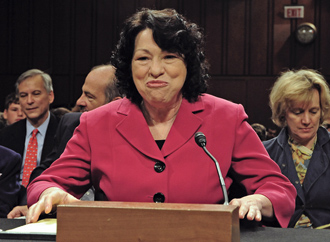 Cynthia Hogan ’79 (right) escorted Sonia Sotomayor on visits to nearly all 100 U.S. senators prior to her confirmation as Supreme Court justice. (photo by Karen Bleier/AFP/Getty Images)
Cynthia Hogan ’79 (right) escorted Sonia Sotomayor on visits to nearly all 100 U.S. senators prior to her confirmation as Supreme Court justice. (photo by Karen Bleier/AFP/Getty Images)
Cynthia Hogan came to Oberlin because she was interested in art restoration. Three decades later she occupies a stately office on the second floor of the Old Executive Office Building as Vice President Joe Biden’s senior counsel.
"It’s the great Oberlin story,’’ she says.
It started with Philosophy of Art, taught by Norman Care. That led her to Philosophy of Government, an eye-opening experience. Law school led her to a job at the Senate Judiciary Committee, chaired by Delaware Senator Joe Biden. And by last summer, she was helping Obama select a Supreme Court nominee.
"I saw that you can change the world,’’ Hogan says of her Oberlin days, and her switch from art to government. "That’s where the Oberlin piece came in.’’
After five years with Senator Biden, Hogan took a 12-year professional leave to raise a daughter and son. Shortly after the 2008 election, the vice president-elect called. He wanted her back.
She agreed to return, but at four-fifths time, which at the White House often translates into 80-hour, rather than 100-hour, weeks. But the arrangement allows her to pick up her kids from school.
When Supreme Court Justice David Souter announced his retirement, Obama called on his VP’s counsel and her judiciary committee background. Hogan helped winnow the list of potential nominees to four and ushered each into the Oval Office for a meeting. Sonia Sotomayor won the job.
"She is an incredible combination of tough and warm. She’s a people person,’’ says Hogan, who escorted Sotomayor on personal visits to nearly all 100 senators.
Hogan is now back to her regular job—providing legal counsel to the vice president on internal matters such as personnel and compliance, and on high profile policy issues such as regulatory reform, prisoner renditions, and the Patriot Act.
Hogan is too busy to decorate the nearly barren walls of her oversized office (it held 10 cubicles for Dick Cheney’s national security team in the last administration). But she hasn’t given up on art. As a student, Hogan stood in line to rent a piece from the Allen Memorial Art Museum—an original Helen Frankenthaler. For her 20th wedding anniversary, she and her husband, Mark Katz ’79, splurged on a Frankenthaler for their home.
Martha Nace Johnson ’74
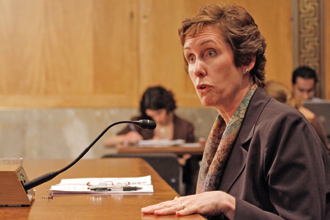 Martha Johnson ’74, Obama’s choice to run the General Services Administration. (photo by Associated Press/Harry Hamburg)
Martha Johnson ’74, Obama’s choice to run the General Services Administration. (photo by Associated Press/Harry Hamburg)
Martha Johnson never touched a computer during her four years at Oberlin. When her econometrics course required number crunching, she and her classmates filled out punch cards and dropped them off at the physics building to be tabulated overnight.
Today, Johnson is Obama’s choice to run the General Service Administration (GSA), the agency that among other things operates the federal government’s Internet domain (.gov).
How did she end up in position to run a bureaucracy that manages tens of billions of dollars of real estate, procures supplies for more millions of federal workers, and manages the government’s computers?
It’s a journey that includes Shansi, business school, diesel engines, corporate consulting, and chocolate-chip cookie dough ice cream (Johnson was a classmate of Jerry Greenfield ’73 and worked briefly for the Vermont ice cream company founded by Greenfield and Ben Cohen).
"So many experiences. Never single-minded. That’s so Oberlin,’’ Johnson says.
But the path wasn’t so evident when she arrived at Oberlin in the fall of 1970, four months after the shootings at Kent State.
"I had no idea what the GSA was,’’ Johnson concedes with a laugh. But she quickly embraced a familiar Oberlin dream. "I wanted to run an organization. A nonprofit; and it would save the world,’’ she says.
From her oak-paneled office at the GSA, the same room that once belonged to Franklin Roosevelt’s famed Interior Secretary Harold Ickes, Johnson now has her chance.
With a staff of 12,000 employees and 11 regional offices, Johnson plans to spotlight several priorities with an Oberlin ring: the greening of federal buildings with $5.5 billion in stimulus money, an overhaul of the government’s public computer profile to fulfill Obama’s mandate for openness and access, a push for education, and training of the work force to improve efficiency.
And Johnson has a very Oberlin idea—perhaps a fantasy, she acknowledges—to humanize the thousands of government buildings she will oversee: she’d like to see a piano in every lobby.
Tom Frieden ’82
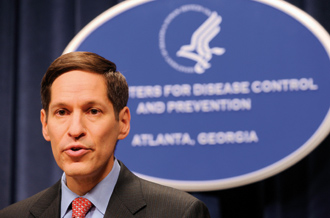 Obama tapped former NYC health commissioner Tom Frieden ’82 to head the Centers for Disease Control and Prevention. (photo by Associated Press/Erik S. Lesser)
Obama tapped former NYC health commissioner Tom Frieden ’82 to head the Centers for Disease Control and Prevention. (photo by Associated Press/Erik S. Lesser)
Tom Frieden recalls burrowing into a cubicle in Mudd library from which he produced a 200-page honors thesis on 20th-century Austrian philosopher Ludwig Wittgenstein. Among the lasting lessons: that two different perspectives, although logically inconsistent, can be equally valid.
It’s a lesson, he says, that serves him well as he strives to couple policy and organization as director of the U.S. Centers for Disease Control and Prevention (CDC).
No Oberlin alum has been more visible than Frieden over the past year. His 14,000-person agency has been at the forefront in battling the H1N1 flu pandemic.
"Responding to the pandemic of H1N1 has been enormously challenging,’’ Frieden says. "At the same time, it has generated much interest in public health’s abilities and functions.’’
Frieden’s story is compelling. He was a doctor in rural India setting up tuberculosis clinics in 2001 when the horror of September 11 compelled him to return home to New York. Mayor-elect Michael Bloomberg, whom Frieden had never heard of, tapped him to be the city’s health commissioner, and Frieden soon made his presence known. He successfully pushed a smoking ban in bars and restaurants, a ban on trans fats, and campaigns for breast-feeding and for drinking tap water. In his fight against AIDS, he branded specialty condoms with a map of New York and even placed a jar of free prophylactics on his desk.
All that work was not lost on Obama, who in May named Frieden to head the Atlanta-based CDC, where Frieden says he will continue to emphasize prevention. After all, "prevention is the best buy in health.’’
Frieden also sees clear links between his Oberlin experience and his current responsibilities. "There are a lot of resonances between the CDC and Oberlin: commitment to justice, commitment to knowledge, commitment to equality,’’ he says. "People at the CDC want to change public health to make the world better.’’
Jacqueline Berrien ’83
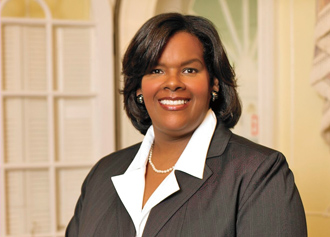 Jacqueline Berrien ’83 protects equality in the workplace as chair of the Equal Employment Opportunity Commission.
Jacqueline Berrien ’83 protects equality in the workplace as chair of the Equal Employment Opportunity Commission.
Jacqueline Berrien left Washington, D.C., for Oberlin in 1979, drawn by the college’s reputation for liberal arts and music and its long history of opening doors to women and students of color.
Thirty years later she is positioned to keep opening those doors.
As Obama’s choice to chair the Equal Employment Opportunity Commission (EEOC), Berrien will oversee a 2,200-member staff, a $342 million budget, and 53 field offices aimed at fighting job discrimination.
The post is a natural for Berrien, who has held a series of high-profile jobs promoting social justice. She had served as program officer in the Ford Foundation’s Peace and Social Justice program; attorney with the American Civil Liberties Union Women’s Rights Project and for the Lawyers’ Committee for Civil Rights; and most recently, assistant director of the National Association for the Advancement of Colored People’s Legal Defense Fund.
"The scope of [the EEOC] is to eliminate unlawful discrimination in the workforce, which potentially affects almost everyone in the country,’’ Berrien says. "It’s completely in line with what I’ve done, what I’ve cared about, and what I’ve worked to achieve throughout my career.’’
Berrien credits Oberlin for helping to foster her passion. She recalls influential visits to Oberlin by civil rights luminaries, such as Bill Robinson ’63, who was then executive director of the Lawyers’ Committee for Civil Rights Under Law, and U.W. Clemon, Alabama’s first African American federal judge, for whom she would clerk after law school.
"Oberlin was an incredible place for me to see how advocacy and organizing happened,’’ she says.
After Oberlin, Berrien attended Harvard Law School, where she was general editor of the Harvard Civil Rights-Civil Liberties Review. And although she graduated a year before Obama arrived, in her final year she befriended a first-year student named Michelle Robinson, who would go on to marry the future president.
"When I was at Oberlin, I always expected I would return home to D.C. and work for the government. I didn’t know it would take so many years,’’ says Berrien, who has made Brooklyn her home for the past two decades.
Joe Reinstein ’87
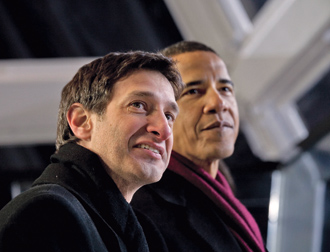 As deputy social secretary, Joe Reinstein '87 oversees cultural and annual events for the White House. (photo by David Kennerly)
As deputy social secretary, Joe Reinstein '87 oversees cultural and annual events for the White House. (photo by David Kennerly)
Nothing Joe Reinstein did at Oberlin could have foretold his prominence in the world of music.
He had friends in the conservatory and enjoyed banging on the piano. He fondly recalls watching many performers on campus, from Livingston Taylor to the Oberlin folk duo Hannah and Jane (he has since married Hannah Higgins ’88).
But it never occurred to Reinstein, a government major, that someday he’d be hugging Stevie Wonder at the White House, booking Ziggy Marley to play at the Easter Egg Roll, or describing the U.S. Marine Corps Band as "incredibly versatile’’ and "incredibly cool.’’
Reinstein is the deputy social secretary in charge of White House cultural and annual events. It’s a job that sounds like a Mudd-induced daydream.
From his East Wing office, Reinstein is charged with bringing music to the White House and fulfilling Obama’s promise to shine a light on the arts. Artists like Wynton Marsalis, Alison Krauss, Charley Pride, Tony Bennett, Gloria Estefan, Marc Anthony, Los Lobos, Sheila E., Pete Escovedo, Joshua Bell, Alisa Weilerstein, and Stevie Wonder have already put in appearances.
"Stevie Wonder is a good hugger,’’ Reinstein says.
Reinstein came to the White House after spending nearly two decades at some of the largest advertising agencies in the world, working on socially progressive causes as well as familiar products and companies such as Cap’n Crunch and Taco Bell. He and Obama had a mutual friend in Desiree Rogers, current White House social secretary, whom Reinstein met when she was director of the Illinois Lottery.
After Rogers was named to her position in the White House, "I immediately congratulated her, and the next thing I knew I was moving to Washington the day before the Inauguration,’’ Reinstein says.
Marc Sandalow teaches politics and journalism at the University of California’s Washington Center. His book, Madam Speaker: The Life, Times and Rise of Nancy Pelosi, was published in 2008.
They Also Serve
The role of Oberlin alumni in the new administration extends beyond the five profiled here. Some alumni serve in staff positions, while others serve as informal advisors or as members of federal panels. Among them:
Tamara Cofman Wittes ’91, deputy assistant secretary of state for Near Eastern affairs at the U.S. Department of State
Peter Lavoy ’83, deputy director of national intelligence for analysis
Desiree Pipkins ’06, staff assistant to the White House Counsel’s office
Edward F. Hartfield ’72, member, Federal Service Impasses Panel, Federal Labor Relations Authority
Katherine "Kit" Batten ’96, science advisor to the deputy director of the Department of Interior
Georgia Yuan ’75, deputy general counsel for post-secondary education and regulatory service, U.S. Department of Education
Know of additional alumni in positions in the new administration? Let us know and we’ll list them in a future issue of OAM.
